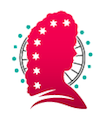The European Endometriosis League, in conjunction with the World Endometriosis Society held the 4th European Congress on Endometriosis in Vienna on 22-24 November 2018. Congress President, Peter Oppelt, promised an approach that would ‘turn endometriosis upside down’.
The meeting began with excellent pre-congress courses on transvaginal ultrasound in deep endometriosis, a laparoscopic skills workshop, and the EEL “endometriosis school” to brush up one’s knowledge, along with live surgery sessions.
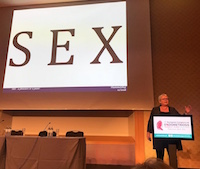
Lone Hummelshoj
Chief executive of WES presenting at EEC2018
Lone Hummelshoj opened the meeting with a provocatively titled talk “Sex – a pleasure or a pain?”, a well-received talk that highlighted the prevalence of dyspareunia and consequent impact upon relationships and placed the woman at the centre of care. She reminded us that we need to accurately identify which pain symptoms women present with and treat their symptoms on an individualised basis.
Krina Zondervan gave an excellent overview of the current understanding regarding the heritability of endometriosis, how genome wide association studies (GWAS) studies have contributed to this, and the need for accurate phenotyping in large data sets. This underscores the importance of the World Endometriosis Research Foundation (WERF) EPHect project for harmonisation of biobanking and data collection in endometriosis.
There was an excellent session on classification in endometriosis led by Carla Tomassetti, Uwe Ulrich, and Neil Johnson. This included a review of the current classification systems as well as the need for systems that correlate with symptomatology and provide prognostic outcomes. The ongoing lack of consensus on core reporting outcome sets in endometriosis was highlighted as well as a hope that the new World Health Organisation disease classification (WHO ICD-11) for endometriosis will be more clinically relevant and facilitate accurate description for coding, statistics, and research.
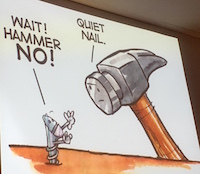 An excellent session on pain was led by Sylvia Mechsner. Data presented by Annemarie Schweizer-Arau and Ingeborg Kremen-Pilz highlighted the role that both psychotherapy and osteopathy can play in pain management. Shaheen Khazali opined that whilst surgeons will continue to operate (‘when you have a hammer, everything becomes a nail’) he wondered how history would judge us for the surgeries done.
An excellent session on pain was led by Sylvia Mechsner. Data presented by Annemarie Schweizer-Arau and Ingeborg Kremen-Pilz highlighted the role that both psychotherapy and osteopathy can play in pain management. Shaheen Khazali opined that whilst surgeons will continue to operate (‘when you have a hammer, everything becomes a nail’) he wondered how history would judge us for the surgeries done.
Moamar Al-Jefout gave a thought-provoking lecture on microscopic and asymptomatic disease. He highlighted deficiencies in our knowledge of the natural history of endometriosis and the lack of evidence. He concluded that whilst asymptomatic disease should not be treated there is a need for continued education.
Marc Possover gave an overview of neuropelvology, and highlighted how a thorough history and clinical examination can identify neural involvement. Whilst treatment is radical, if nerve involvement is appropriately treated the impact on pain resolution can be striking. The technical challenges of this type of surgery are clearly significant and delivery of this type of surgery will likely remain the remit of a few specialist centres.
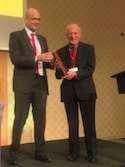
Dr Martin Sillem presents professor Ivo Brosens with the EEL’s Rokitansky award
Peter Barton-Smith gave a comprehensive summary of the current literature with regard to the use of robotic surgery in the management of endometriosis, including the good, the bad and the poorly designed clinical trials. Clearly there is a learning curve and a need for appropriate case selection. As a result, some of the initial comparative studies are not so clear cut as their data might suggest.
The Rokitansky Award was presented to Professor Ivo Brosens for his outstanding contribution to the field of endometriosis including work on neonatal menstruation.
The meeting culminated in an outstanding lecture by Patrick Groothuis on “The state of the art in endometriosis drug development: the promise the hype, and the reality”.
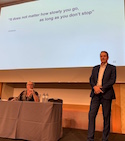
Patrick Groothuis presenting at EEC2018
He gave an elegant outline of the history of drug discovery in endometriosis, highlighting that hormonal approaches are almost fully evolved. As a result there is a need to intensify efforts to identify novel targets. The audience was reminded that endometriotic tissue is not analogous to endometrium and that parallels can be drawn from the behaviour and function of cancer associated fibroblasts.
Take home messages included “thinking outside of the box”, the need to look to non-hormonal treatments to ameliorate symptoms, and that clinicians and scientists need to collaborate with pharma to translate bench side discovery into meaningful treatments.
The meeting ended with a look forward to EEC2019 in Prague, and to the next World Congress on Endometriosis, in Shanghai in 2020. See you there!
About the author
Lucy Whitaker obtained her medical degree from the University of Edinburgh in 2007. She is undertaking postgraduate training in obstetrics and gynaecology in Edinburgh where she is the South-East Scotland advanced laparoscopic trainee for the excision of benign disease, including endometriosis and fibroids.
Her research interests are in chronic pelvic pain and heavy menstrual bleeding. She has contributed to the peer-reviewed literature and continues to focus on translational research in endometriosis-associated pain and heavy menstrual bleeding. She is a Junior Ambassador for the World Endometriosis Society.

